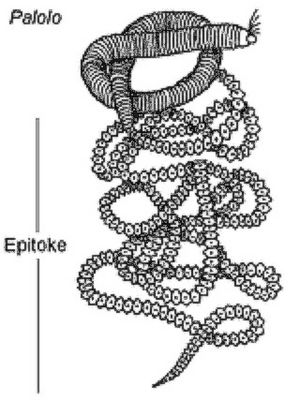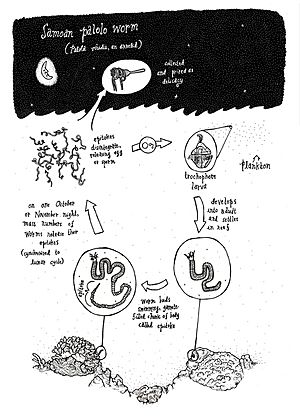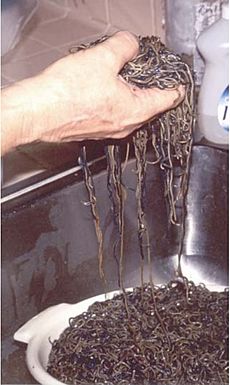Palola viridis facts for kids
Quick facts for kids Palola viridis |
|
|---|---|
 |
|
| Conservation status | |
| Scientific classification | |
| Genus: |
Palola
|
| Species: |
viridis
|
| Synonyms | |
|
|
The Palola viridis, also known as the palolo worm, is a special type of sea worm. People in different places call it by other names like balolo, wawo, or nyale. These worms live in the waters around many Pacific islands. You can find them near Samoa, Tonga, Fiji, Vanuatu, and islands in the Malay Archipelago. This includes places like Indonesia, Timor-Leste, and the Philippines.
Life Cycle
Palolo worms have a very interesting way of reproducing. They all release their eggs and sperm at the same time. This happens at night during spring or early summer. In the Southern Hemisphere, this is usually in October or November.
During this time, the very end parts of their bodies break off. These parts float to the surface of the water. They then release the sperm and eggs into the sea. Scientists are still learning exactly what makes them do this. It usually happens during nights when the moon is getting smaller. This event can last for several nights in a row.
After the sun comes up, the "tail" parts of the worms are destroyed by the sunlight. In Fiji, a local red land crab goes to the sea just before the palolo worms appear. In Samoa, a crab called mali'o also goes to the sea around the same time. Other sea creatures, like sharks and fish, also come to lay their eggs during this special event.
Where Palolo Worms Live
The palolo worm lives in warm, tropical areas of the Pacific Ocean. You can find them near islands like Samoa, Tonga, Fiji, Indonesia, and Vanuatu. They also live around some islands in the Philippines.
In these tropical places, palolo worms usually stay in shallow waters. They like to hide in broken coral pieces. This gives them shelter and a safe place to live.
Palolo Worms and People
For some people living in these regions, the palolo worm is a special food. It is considered a delicious treat. The worms only appear for a short time each year. This is usually during the last quarter of the moon in October and November.
People gather the worms using nets or buckets. They can eat them raw, or they can cook them in different ways.
In Samoa, people really value the worms as a great food. They go hunting for them seven days after the first full moon in October. The worms are often bright blue. People say they taste like a mix of mussels, abalone, and oysters. Sometimes they are eaten fresh. But often, they are fried with butter and onions. They are usually served with taro or banana chips.
The palolo harvest is a big part of Samoan culture. Families and relatives share the feast together. In recent years, these worms have also been sold in markets. You can find them in Apia and Salelologa. They can cost more than A$100 for one kilogram.
On the island of Lombok in Indonesia, there is a traditional event. It is called the Nyale Festival, or Bau Nyale. This means "to catch the sea worms." This festival happens between February and March. The main goal of the event is to catch these worms, which are called wawo there. A local legend says that the nyale worms are the new form of Princess Mandalika. She is believed to have jumped into the sea long ago.
The time when the worms appear is very important to people. For example, in the Torres and Banks Islands of Vanuatu, this event is even part of their lunar calendar.




